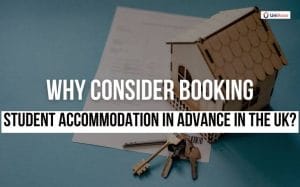The hunt for student housing can be an adventure filled with both excitement and anxiety. Your university home will shape your academic experience and day-to-day life. While finding the perfect fit may seem daunting at first, taking a methodical approach can set you up for housing success. This guide outlines key factors to consider when evaluating rentals, from financial logistics to amenities to location. Arm yourself with the right information before signing any student tenancy agreement. We will explore warning signs to watch out for, questions to ask landlords and tips for a seamless move-in. With the right preparation, you can secure quality, comfortable student accommodations suited to your needs and budget. The treasures are out there in the rental market – let’s start digging.
Things For Students To Check Before Signing A Student Tenancy Agreement
Student accommodations are your home away from home and making sure that it is top-notch should be on your priority list. Here are the top things students should review before signing a student accommodation tenancy agreement.
Start and end dates
Ensure that the start and end dates on your student tenancy agreement are correct and match your expectations. The contract should clearly state the commencement date when you can move in and collect the keys, as well as the end date when you must vacate. Typical student lets run 12 months from July to June. Review the dates closely and calculate term times/exam periods to ensure sufficient rental coverage.
Names on the contract
Make sure that your name on the student tenancy agreement is correctly spelt and matched to the identification documents that were supplied. Both individual and joint contract types should list all tenant names, not just lead tenants. Having your name on the contract gives you full rights and responsibilities as an occupant. Likewise, confirm that the landlord or letting agency details are accurate in case issues arise later requiring their contact.
The Deposit
Landlords usually ask for a cash deposit before you move in, typically around a month’s rent. This deposit money acts like a security fund in case you damage things or fall behind on rent payments later on.
By law, your landlord must put your deposit in a government-approved protection plan within 30 days of receiving it. These plans keep your money safe during your lease. Make sure you get the scheme details from your landlord.
Check that they did register your deposit properly. If not, you could get up to 3 times the deposit amount back! But this situation is rare. More often, disputes happen over mystifying deposit deductions for questionable damages when you move out.
Rent amount
Carefully check the rent amount stated in your student tenancy agreement, including whether the price is per week, per month, or per term if in university accommodation. Confirm exactly who is liable to pay, such as individual tenants or joint liability for the whole property.
Understanding rent responsibility prevents nasty surprises if someone departs early. Use online rent calculators to validate that the quoted price aligns with average rates in your area based on the number of bedrooms.
Deposit amount and protection
Along with rent, closely review the deposit amount requested, which is often equal to 5 weeks’ rent.
Check that it matches what you already paid upon signing. More crucially, ensure that the deposit protection scheme used is named, such as DPS, to confirm it will be properly secured in an authorised government program. Review deposit return policies, disposal requests, and protected status without which landlords face steep.
Tenant and landlord obligations
Review in detail the obligations and responsibilities of both tenant and landlord during the rental period. For tenants this normally entails standards on cleaning, property maintenance, permitted alterations, and proper usage of included appliances. Restrictions may also apply on pets, guests, subletting rooms, etc. Give special attention to any areas of liability for covering repairs or utility bills.
Inventory
Scrutinise every line of the inventory checklist that outlines current furniture, appliances, and condition of the property when moving in. Flag any inconsistencies in items provided versus the listing advert or enable photographic evidence. Both parties must sign off on the inventory as an accurate assessment of the initial rental state to prevent unfair charges for pre-existing damage when moving out. Upon visiting, take your own photos to supplement inventory notes, time-stamped for additional validity and clarity. A thorough inventory prevents many deposit arguments down the line.
Utility Costs
Be sure to inquire about the average monthly costs of all utilities you will be responsible for paying, including electricity, gas, water, sewage, garbage pickup fees, and internet if not included. Compare costs of included utilities vs finding your own cheaper service providers. See if the property allows split utility payments if sharing with housemates. Factor in expected utility deposits required upon activation as well when planning finances.
Insurance Requirements
Verify in the lease documents if purchasing renter’s insurance is mandatory for all occupants, which covers replacing belongings and temporary lodging costs if the unit is damaged and deemed uninhabitable. Even if not compulsory, having renter’s insurance as a student for liability, personal property, and additional living expense coverage can provide peace of mind by protecting your possessions in the event of theft or property damage due to fire, water leaks etc.
Local Authority Registration
Importantly, check that the property has been officially registered as a rental unit with your Local Authority, which is required by law for landlords in the UK. This registration provides oversight that essential quality and safety standards are met in your student tenancy. Look up the property on public registers and request to see the landlord’s certificate to validate they have undergone necessary inspections.
Ensuring Neighbourhood Safety
Look into the crime rates of the area where the property is located before signing the student tenancy agreement. You can find this information through online resources or by contacting local law enforcement agencies. Pay attention to any trends or recurring incidents that may raise concerns.
Seek out reviews and feedback from current or former residents about their experiences with safety in the neighbourhood. Online forums, social media groups, and student housing websites can be valuable sources of information.
What Is The Importance Of Student Tenancy Agreements?
The importance of student tenancy agreement in the UK lies in their role as legally binding documents that detail living arrangements and rights in the property. These agreements are essential for several reasons:
Legal Protection: They provide legal protection for both tenants and landlords by outlining the terms of the tenancy.
Clarity on Responsibilities: They clearly define the responsibilities of both parties, including rent payment, maintenance, and end-of-tenancy procedures.
Rights and Obligations: They specify the rights and obligations of the tenants, ensuring that they are aware of what is expected of them during the tenancy.
Financial Commitment: They serve as a financial commitment, ensuring that tenants understand the financial implications of the tenancy, such as the deposit and rent payments.
Prevention of Disputes: They help prevent disputes by providing a reference point for resolving any disagreements that may arise during the tenancy.
Final Thoughts
By understanding key factors of student hostel tenancy agreement upfront, you can avoid nasty surprises down the road. Scrutinise listings, speak to current and past residents and trust your instincts on any red flags. The work you put in now pays dividends through a comfortable, stress-reduced year ahead.
With deposit signed and keys in hand, you can finally relax knowing your home away from home meets both practical and financial needs. And if any issues emerge, you’ve armed yourself with the knowledge to take action. Here’s to an amazing year settled into your new student pad!
FAQs
What is a tenancy agreement for a room in the UK?
Room rental contracts, known legally as Assured Shorthold Tenancies (ASTs), represent a prevalent type of leasing arrangement across the UK student housing market. ASTs govern the rental of an individual bedroom within a shared apartment or house.
What is the lease length for student accommodation UK?
Landlords generally require strict 12-month tenancy agreements without flexibility for shorter lease terms. This implies that tenants must rent the accommodation starting before the academic period commences and continue paying rent throughout the summer holiday even when potentially vacant.
Can I rent in the UK with a student visa?
Students with either a valid UK visa or a pending visa application in process have the legal Right to Rent housing while living in the country as foreign nationals. However, they must be prepared to show documentation confirming this rental eligibility status to prospective landlords or letting agencies during the viewer screening process before a property can be offered.
What is the minimum student tenancy agreement in the UK?
The minimum period you will get is 6 months.
Can you sign 2 tenancy agreements in the UK?
It’s super important to make sure any rental agreement you sign as a student doesn’t overlap with dates from another contract you’ve already signed. All leases are legally tight – if you double sign for the same months, you get slapped having to pay for both places!















0 Comments